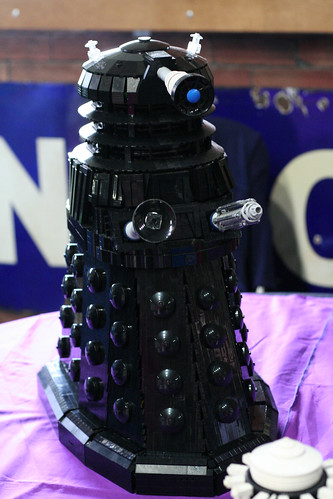There's this little folding knife, made by Boker, called the "Boker Plus Credit Card Knife". Its unique selling point is that if you remove its pocket clip and fold the knife up, it'll fit in a credit-card pocket in your wallet.
The Credit Card Knife has a gratuitous titanium handle, lightening cut-outs and some other silly bullet-point features, and its street price is about $US20. Opinions concerning it are mixed, though, chiefly because it uses a modern blade-safety idea, but not very well.
The blade of a normal folding knife folds into a slot in the handle. The Credit Card Knife's handle is just one flat piece of metal, next to rather than around the blade, but the the blade is chisel-ground - one side has an edge ground on it, and the other side is flat. When closed, the blade's flat side lies flush against the handle, so it can't cut anything.
Peculiar-knife megabrand Columbia River Knife and Tool use this design on their popular, and excellent, "K.I.S.S." and "P.E.C.K.
" lines. It works really well, as long as the blade lies perfectly flush with the handle.
The design of the Boker knife means the edge doesn't actually lie quite flat on the handle. There's a gap, of maybe half a millimetre at best, but that's enough for the blade to retain some wood-plane-like cutting power. The knife is still fine to keep in a wallet, but not great to have bouncing around in your pocket, and if you run your finger down the edge when it's folded, you can give yourself a shallow cut.
The Boker's list price is a bit steep, too; it's $US34.95. You can get one for $US21.66 ex delivery on Amazon, or for $US21-ish delivered on eBay.
When you buy cheap major-brand knives cheap on eBay, though, there's a significant chance you're getting a Chinese knockoff (as opposed to the genuine article, often also made in China...). The quality of knockoffs can be very good; many Chinese factories sneakily make extra units of whatever they're contracted to make when the company that contracted them isn't looking, or similarly sneakily sell on units that failed quality-control testing, possibly only for cosmetic reasons.
Other Chinese knockoffs, though, are obvious, because they're only broadly similar to the item they're copying.
Which is the case here.
This knife (which carries the "Columbia" pseudo-brand, entirely unassociated with Columbia River) is a shameless, but far from identical, copy of the Boker. It has the same blade-gap problem, but it lacks the gratuitous titanium handle and other fripperies, and it's substantially cheaper.
As I write this, eBay Buy It Now prices for this knockoff are up around $US11, or you can lowball various auctions [UPDATE: I've improved that eBay search to find this knife under some more names] until you get one much cheaper. My 1337 eBay sniping skillz got me this one for $AU2.75 delivered, at which price I think a knife is good value even if it opens in your pocket and stabs you in the femoral artery and your lifeless body is later found in the middle of a huge congealing pool of blood.
Folded up, the knockoff knife is about 66mm wide by 33mm high (2.6 by 1.3 inches), by 3mm thick if you only count the blade and the handle. Or about 7mm thick at the hinge pin, which is a simple button-head hex screw instead of the show-off hollow pin of the Boker original. Or about 9mm thick, if you include the hinge pin on one side and the removable pocket clip on the other.
It weighs about 36 grams (1.3 ounces) with the pocket clip, about 33 grams (1.2 oz) without. The Boker original is 1.1 ounces, about 31 grams, with pocket clip. Yep, that titanium handle's totally worth the extra money!
A standard credit card has a much larger footprint - about 86 by 54mm - but is much thinner, only about 0.7mm overall or about 1mm if you include raised lettering. But because this knife's height-by-width footprint is so small, it still fits OK in a credit-card wallet pocket, despite being at least three times as thick as a card.
I'm still not totally sold on the keeping-it-in-your-wallet idea, though, especially if you're one of those strangely numerous weirdos who put their wallet in a back pocket and sit on it all the time. Do that, and the little knife will try pretty hard to snap any credit cards it's being forcibly stacked up next to.
You could tuck the folded knife at one end end of a zip-up back-of-wallet pocket, though; it's also just about perfect for the little "Zippo pocket" in a pair of jeans. Many, many other possible locations suggest themselves, for such a tiny knife. The miscellaneous side pocket of your camera bag. Stuck to some other steel object with a magnet. Your car glovebox. You get the idea.
If you want to clip the knife onto a pocket, though, you're probably going to have to fiddle with it a bit. The clip on the knife I got was way too springy, requiring a ridiculous amount of pants-mangling effort to jam it onto anything. When I bent the clip back a bit, though, it worked.
The preferable way to bend the clip is by removing its three retaining screws with a little #8 Torx driver or similarly tiny Allen key, and then bending the clip in a vise. Just jamming a chunky flat screwdriver under the clip and levering will probably work too. From past experience I expected the clip to just snap when I tried to bend it, because "$2.75 Chinese folding knife" and "meticulous heat-treating of springy components" are terms not often found near each other. But it actually worked fine, on my knife's clip at least.
The knife is easiest to use without the clip on it at all. The handle is of course very thin - about 1.3mm - so it's not comfortable to use for long periods of time. But the little finger scallops on the edge of the handle actually give you quite a good index-and-middle-finger grip; it's not an instant ticket to repetitive strain injury like a P-38 can opener.
My $2.75 knife had some other flaws, too. As is usually the case for cheap Chinese knives, the machine-ground blade wasn't sharp all the way to the tip, so I had to touch that up. The rest of the edge is very sharp, though, and the super-shallow chisel grind makes this little knife a surprisingly excellent slicer and whittler, right out of the box.
Fit and finish overall is OK. The shiny metal showing through the cheap black coating on the built-up corner piece of my knife, for instance, is there because I filed that corner down to get the screw-heads flush with the surface. But, much more importantly, the blade's frame lock (an evolution of the liner lock) works well, with almost no play and no desire to close on your hand even if you rap the back of the blade on a table.
(As a general rule, you should be suspicious of cheap liner-lock knives; a poorly-implemented liner lock can and will close on your hand. Get a back-lock, or "lockback", knife instead; they're harder for sloppy manufacturers to get wrong. Or, of course, get a "fixed blade" knife, that doesn't fold at all.)
The smallness of the knife does make it a little dicey to open and close, safety-wise, but the basic stolen Boker design is sound.
For twenty bucks, even the fancy Boker version of this thing is not a tremendously attractive product. This knockoff for ten bucks is decent. For five bucks or less via an auction, it's really nice, and works surprisingly well.
Plus, there is a dragon embossed on it.
A frickin' dragon, dude!
If you just search eBay for credit-card knives, you'll currently find a lot of these "survival tools" (I bought one; it's about as convenient to use as you'd think, but it is indeed small and any tool is better than no tool), and also a lot of knockoffs of the Ian Sinclair CardSharp. The CardSharp and its copies have the dimensions of a normal credit card, with a blade in the middle; the rest of the thing cunningly folds around the blade to make a handle. I don't know if the CardSharp knockoffs are any good, but they sure are cheap, so I bought one and will write about it when it arrives.
































